Arthropod Injury
Plum Curculio: I see two forms of PC injury at harvest time.
1) Typical PC injury is created when the fruit is very young. It is a healed scar, up to one inch (size depends on fruit enlargement) long. It often takes on a D shape, with the flap (under which the egg was laid) still discernable along the straight edge. Sometimes the middle of that straight edge is interrupted by a bulge of grainy tissue (where the egg was; top right photo). If the egg hatched, the fruit may be gnarled and misshapen, and cutting it open may reveal the (now healed) signs of the tunnel made by the larva.
2) Late PC injury is from newly emerged adults (August); a relatively fresh hole 2-3mm in size, usually oval, with some dark edges. Skin has not had time to heal over. Location is usually on shoulder of stem end, or on the bottom ridge, towards the calyx end. The right photo below shows a closeup of PC injury in June, when the fruit was small.

Tarnished Plant Bug: TPB injury is a dimple with a grainy spot in the center, OR a grainy spot (roughly round) with a dimple in the center. Often much of the TPB injury in an orchard is hidden in the calyx end, where only inquisitive entomologists would look.

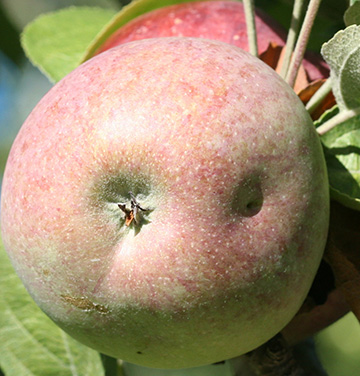
European Apple Sawfly: Two forms: 1) Elongated, curving grainy scar on the fruit surface, which originates in a dimple in the calyx end. 2) Some EAS scars (always in calyx end) are very similar to TPB scars. These are from eggs that didn’t hatch, and seem broader and wider than TPB scars.

Redbanded Leafroller: Recent surface chewing that remove the skin and a small amount of flesh, and is hidden from light by overlying leaf, or (especially in Cortland) another fruit set immediately behind. Redbanded leafrollers must have shelter from light. The caterpillar is often still present in early September, chewing away. Now that oblique-banded leafroller is damaging in some NH orchards, this could also be from OBLR.

Oblique-banded Leafroller: We are starting to see this, but still quite rare in NH. It looks like the beginning of some RBLR injury, but is usually on the exposed face of the fruit, not under a protected leaf. The photo at left below is a damaged Gingergold fruit from southwestern New Hampshire in 2008.

Comstock Mealybug: Sepals in the calyx end of the fruit are black (covered by sooty mold). Cutting away the sepals reveals the whitish mealybug, hidden in the small cavity beneath the sepals. The photo of sliced fruit is old, scanned into digital format. The photonext to it shows the typical appearance without cutting.


White Apple Leafhopper: There are shiny brown flecks of excrement on the upper side of the fruit, below leaves on which the leafhoppers were feeding. Leaves immediately above the affected fruit show white stippling. Heavy rain washes the fruit clean.

Mites: Eggs of European red mite are sometimes obvious as a group in the calyx end of the fruit. They are round, brick red in color. Occasionally (especially later in harvest season) I find groups of bright orange mites on fruit --- these are the over-wintering form of another species: twospotted spider mite. In the photo (below left), several dark, oval European red mites are present below the calyx, in addition to the (smaller) eggs. Mite eggs are easiest to spot on green or yellow-skinned fruit.

Green Fruitworm: A large, deep, irregular, grainy patch is likely to be from green fruitworm. The caterpillar ate part of the fruit early in the year. The injury healed over, leaving a scar that is sometimes very deep, sometimes shallow. This damage is rare on most conventionally-managed blocks, but common in organic or backyard trees.

Climbing Cutworm: A recently chewed hole (up to 1/2 inch across) could be from climbing cutworms, or occasionally other insects. Usually, it is toward the bottom of the fruit. In the photo below, it is closer to the top.

Apple Maggot: Most AM injury is hidden from our view, not visible without slicing open the fruit. Sometimes it is visible as a very slight indentation, accompanied by a tiny hole (often need a 2-10X hand lens to confirm), often accompanied by very slight darkening of the skin around the puncture. Sometimes there is a tiny bit of whitish surface exudate, where juice dried up. (see right puncture in photo below at left) The hole is less than 1mm across, so this is often hard to spot. Much AM injury is missed by visual examination of the surface. Fruit cutting is necessary to get a more reliable indicator of AM attack. AM injury is hard to identify. I see two suspect “stings” in the first fruit below; 3 or more on the second fruit below.
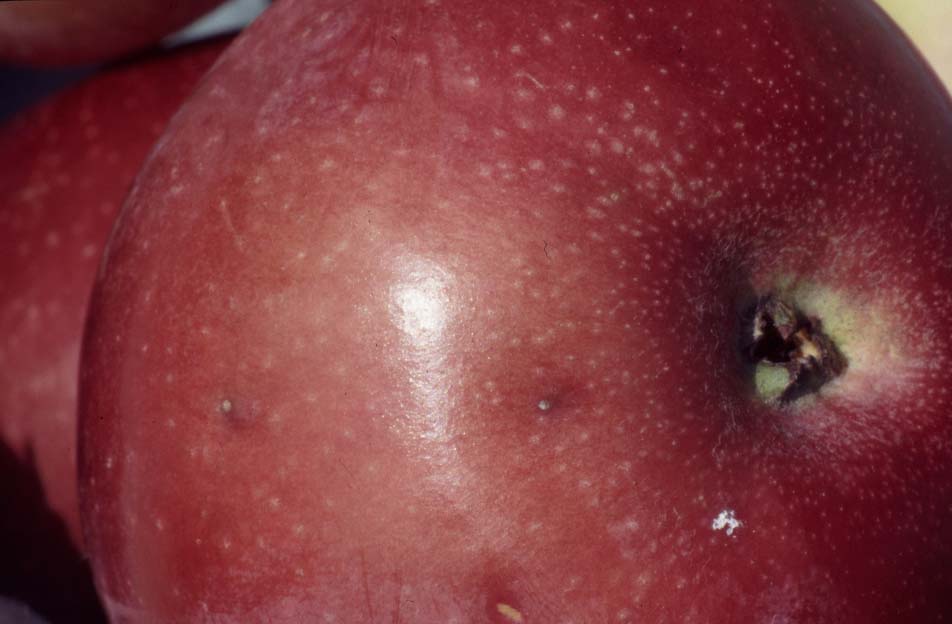

Codling Moth: Codling moth injury on fruit is uncommon in conventionally managed orchards. Reddishbrown frass (fecal pellets), usually at the calyx end, projects out of the tunnel. Codling moth larvae usually tunnel to the core and do some feeding on the seeds, before leaving the fruit and pupating. Occasionally a tunnel is in the stem end or side of the fruit. It could be a tiny blemish, but will show frass pellets coming out of the hole. Larvae can be distinguished from Oriental fruit moth by looking for an anal comb… a tiny, dark comb-like structure very low on the rear end. Both photos below show codling moth damage.

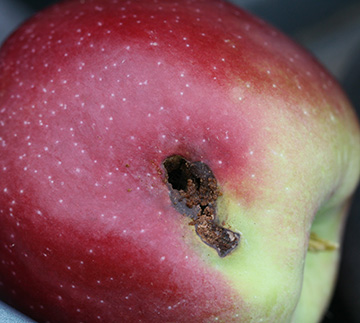
Lesser Appleworm: LAW injury is very similar to codling moth damage, with the same red-brown fecal pellets. LAW tunnels are usually shallow, and don’t go to the core. They often arise on the side of the apple, rather than being hidden in the stem end or calyx end. If you find the caterpillar, you can distinguish this species from CM by looking for the anal comb with a microscope.
San Jose Scale: The scales themselves are tiny, round, raised and grayish. At the time of harvest, those found on the fruit are roughly 1mm across. They would be hard to spot, except a reddish ring forms around each scale. They are most common toward the calyx end. Where you find one, you’ll usually see others. See photo below.

Rosy Apple Aphid: Cortland is the variety most frequently showing this injury. Fruit adjacent to rosy apple aphid colonies are stunted, puckered at the calyx end, and ridged like a pumpkin. The photo on the previous page shows severe injury, with a penny for size comparison. The photo below left shows the crinkled leaves where the aphid colony lived.


Stinkbug: I see what I call stinkbug injury rarely on NH apples, but it will increase once brown marmorated stinkbug builds up in New Hampshire. It is usually a visible puncture, often with a slight depression around it. Sometimes there is slight discoloration there. Cutting into the flesh usually reveals a brown, corked area of flesh. Very careful vertical cutting may reveal the vertical hole made by the mouthparts, visible under a microscope. (Stinkbug injury photo, below).

Infectious Diseases/Pathogens
Apple Scab: Apple scab appears as a dark, rough patch on the surface. Lesions that were initiated early in the season are large, and the fruit may be cracked, since the skin there can’t expand well as the fruit enlarges. Sometimes scab is restricted to the sepals.
Sometimes lesions are very small, having been initiated late in the season by conidia splashed from nearby lesions on fruit or foliage. Such lesions are dark, with the light skin sometimes peeling away from the center. Scab is the most common form of pest injury on New Hampshire apples.


Flyspeck: Flyspeck appears as a group of small black dots on the skin. In severe cases, several groups of dots are apparent. This could be on any surface of the fruit; more common where humidity was high, like in dense foliage. It is easiest to see on yellow varieties.

Sooty Blotch: Without magnification, sooty blotch looks like a gray spot (could be several) on the fruit surface. Viewed with a 10X lens, it looks like a series of black spots. Often it is with flyspeck. It is in the photo below (with a little flyspeck showing, too).

Calyx End Rot: The calyx end of the fruit shows a black area. In some cases it is hard and dry; in others the rot is active and soft. I took the photo (below) in 2007.

Bitter Rot: A rot with obvious concentric rings in the fruit (photo below). The rotted flesh is soft. I don’t see much of this. To confirm, slice the affected fruit in half, through the rotted section and core. If the rotted area is V-shaped, with pointed end toward the core, it is bitter rot.

Black Rot: This looks very similar to bitter rot; sometimes I can’t tell them apart. If I see a rotten area with concentric rings, surrounded by a reddish halo, I consider it to be black rot. The decayed flesh is often firm, not soft. Black rot isn’t V-shaped when you slice through it to the core.
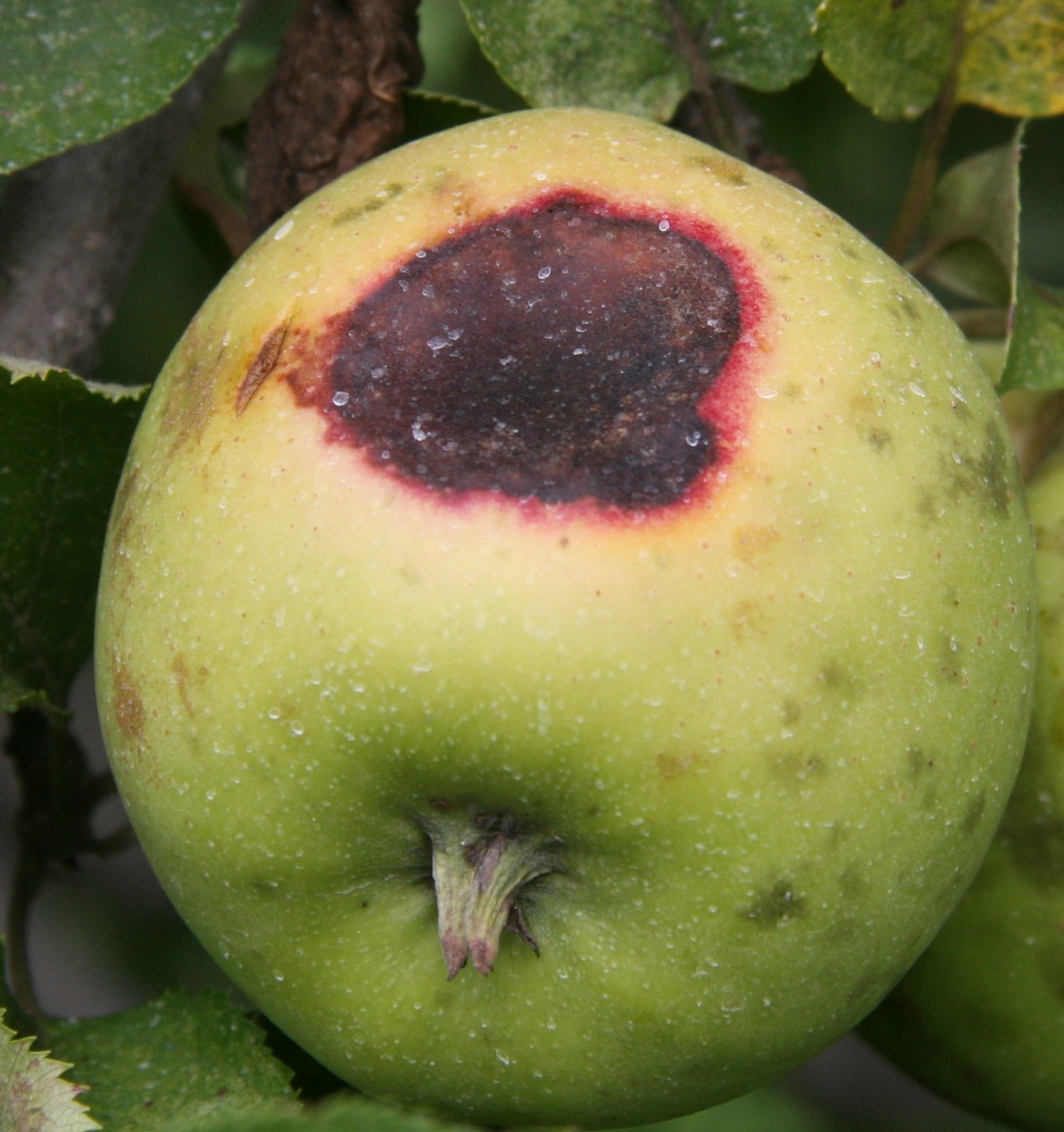
Powdery Mildew: This is not very common in New Hampshire. A netlike pattern of russet could be from powdery mildew. I saw some in 2002 and 2012. (no photo).
Sooty Mold: I see two situations with sooty mold on apples. One is where aphids have dropped honeydew on the fruit. The other is adjacent to a black rot mummy. In both cases, the discoloration can be wiped off. FF is the designation several of us use for this (“fruit finish”). See photo below.

Physical & Mechanical Injury
Stem Puncture: This is where a stem or twig end has punctured the skin of an adjacent fruit, fairly recently. Usually the causal projection is obvious when the fruit is still on the tree.
Rub: This is usually a smooth brownish spot on the skin from repeated rubbing against a branch. In the photo on the next page, the injury is not smooth, but the obstacles that rubbed it are obvious.


Scratch: This is usually a series of parallel grainy lines on the fruit surface, where something long ago scratched hard enough to injure the skin, probably during wind or other movement (see two photos below).


Bruise: This is an indented injury, but the skin is intact. It looks like it was caused by something large hitting the fruit (or vise versa). Farm machinery can cause some of this, for fruit hanging in the drive rows, especially in tight blocks.
Hail: Hail injury takes on different forms, depending on how hard the strikes were, and how much time has elapsed since the injury. Sometimes it can be confused with curculio injury or tarnished plant bug injury. It can appear as a series of dents in the fruit (unbroken skin), or a series of grainy healed-over marks. Lower surfaces of the fruit (at the time of the storm) are not affected; this is a clue to identity. Occasionally the injury heals as outward surface bumps.
Rotary mowers occasionally propel twigs or pebbles into fruit, and cause identical injury. A clue is that very few, primarily lower fruit are affected if mowing was the cause.


Nutritional & Physiological Injury
Bitter Pit: BP is a series of slightly sunken, purplish spots in the fruit. It is most common on Cortland, sometimes Delicious, and Honeycrisp. Large fruit are more prone to this, especially in dry years. This is a sign of a nutritional deficiency (calcium). The photo (below) shows a typical case. Frequently the purple spots are on the side of the fruit, closer to the calyx end.

Calcium Deficiency: In other varieties, scattered purplish spots could be signs of calcium deficiency, but sometimes the term bitter pit isn’t used. Basically, it’s just a second name for the same thing.
Frost (or Frost Ring): A grainy patch that frequently encircles the calyx end of the fruit. Very low temperatures around time of fruit set or early fruit growth seem to be associated with this injury. Occasionally it occurs in patches, rather than rings.

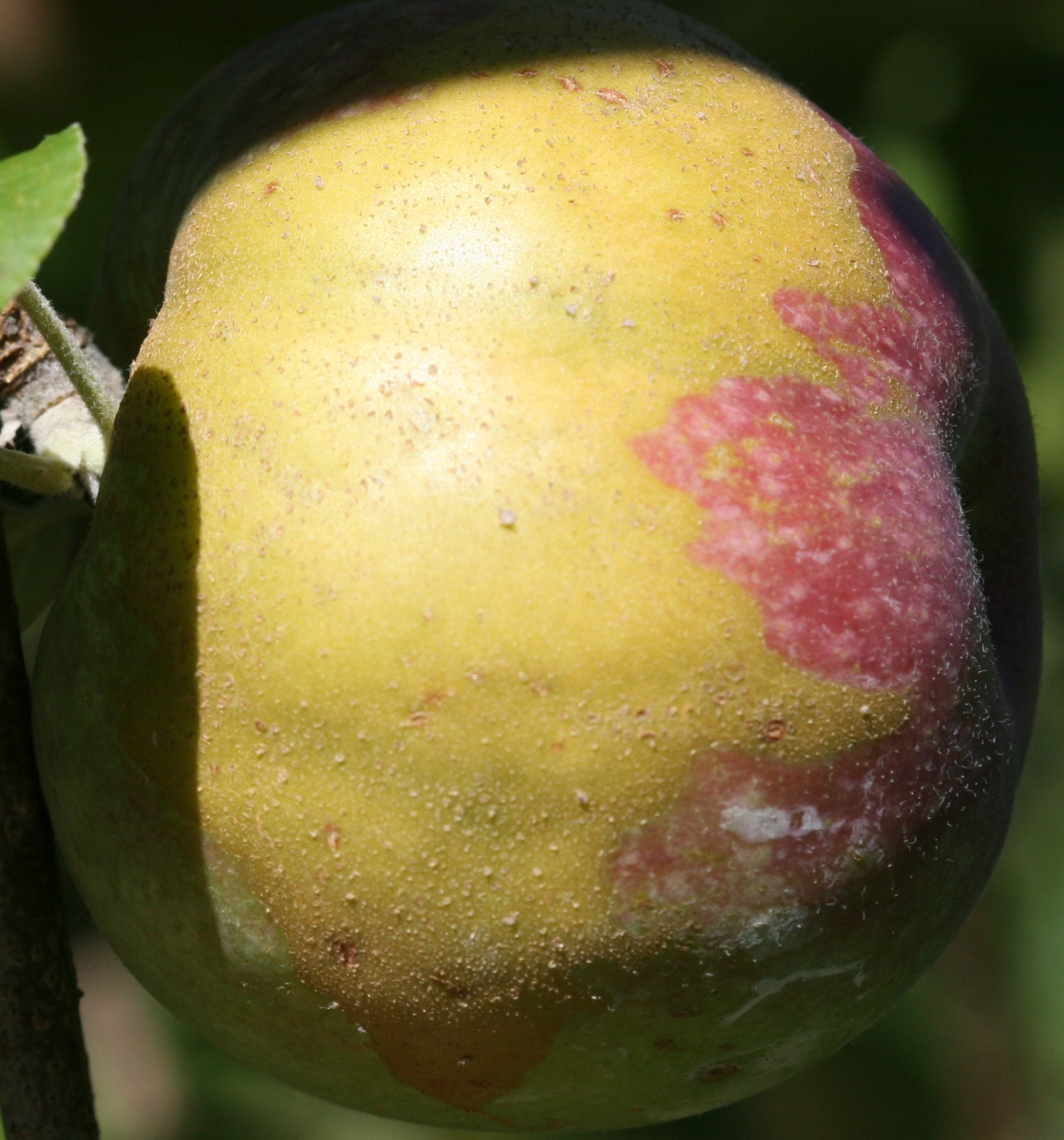

Russet: Russet (photo below) is a grainy patch or grainy network on the skin. Causes are weather conditions, sometimes in combination with pesticides, spray adjuvants, or other sprayed materials. Some varieties are especially prone to develop russet in humid regions or seasons, like Golden Delicious. Golden Delicious fruit grown in Washington State (where it is dry) are smooth skinned.

Crack: Well... it’s a crack in the fruit! Most commonly this is in the calyx end. Macoun is one variety where this is most common.
Physiological Stripe: Sometimes I see this, and it appears to have a genetic or physiological cause, with no obvious outside cause. I notice it most on McIntosh.

Vertebrate Injury
Rodent: This injury appears as fresh chewing, with obvious teeth marks. Affected fruit are usually low enough to be chewed while standing on the ground, OR they are chewed on a spot where there is a convenient place to stand on a branch. Chipmunks, voles and woodchucks are common suspects. Squirrels don’t usually participate, nor do hares & rabbits. Occasionally fecal pellets are left on the fruit.


Porcupine: Porcupines usually leave enough evidence to distinguish their injury from other rodents. Teeth marks are quite large, and large chips of fruit litter the ground. Usually there are broken/eaten twigs and/or branches as well. Delicious is one of the favorite varieties for fruit feeding. The affected tree is often near the orchard edge, especially by woods or stone wall.
Often, a conifer is the home, but any large hollow tree will also suffice. Occasionally, a quill or two is left at the scene, identifying the feeder.

Bird Peck: Sometimes the two halves of the beak leave adjacent punctures, and other times a deep hole is excavated. This is always a fruit by a convenient perch. Blue jays, crows and ravens are the most common suspects. Wild turkeys sometimes peck fruit they can reach from the ground. Bird pecking is usually most common in dry years. (Photo below).

Bird Poop: Bird poop is usually whitish.

All photos are by Alan Eaton. Partial support for this publication came from an Extension IPM Implementation Grant from the National Institute for Food & Agriculture.
Download the Resource for the complete fact sheet and a printable version.

